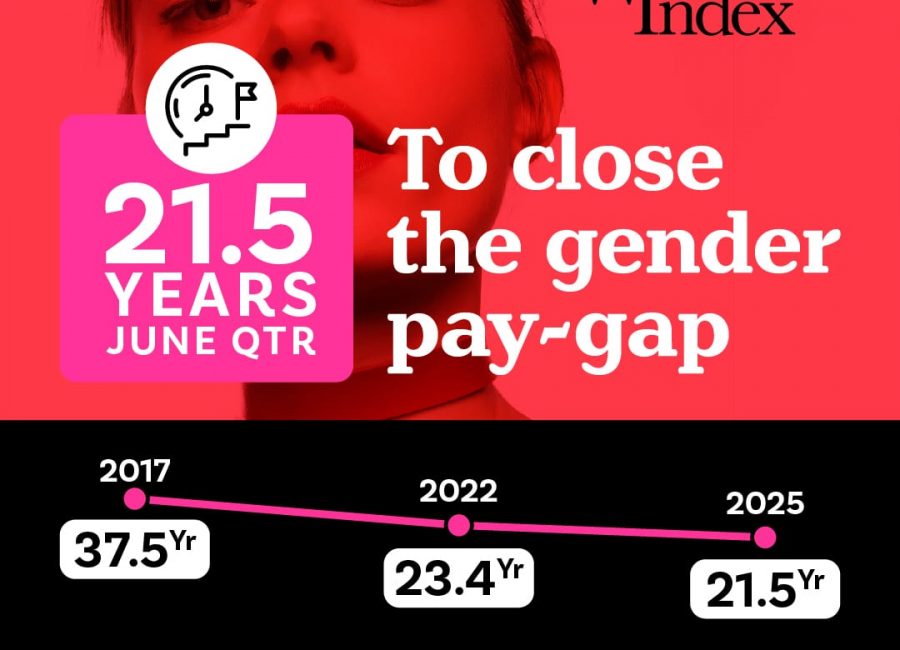Australian women made further financial progress in the September quarter but continue to be held back by nearly a 200-year wait for gender equality in unpaid work.
The latest measure of women’s progress the Financy Women’s Index rose 0.6 points to 124.8 points in the September quarter, from a revised 124.2 points in June.
The September quarter gain was helped by record female full-time employment and a rise in the female participation rate.
However the pace of progress in unpaid work and female board appointments weighed on the September result.
It may decades to change inequalities in the workforce, in pay and possibly centuries to improve equality in unpaid work which we know limit the potential and financial progress of women.
Women occupied 29.5% of ASX 200 board positions in September, compared to 29.7% in June, putting 2019 on track to become the worse year in a decade for improving gender diversity on boards.
In the year to September, the Women’s Index climbed 4.7 points, which is a solid result but not nearly as strong as the 7.1 point gain in the 12 months to September 2018, which reflected a better period for Corporate Australia on board diversity.
The latest result benefited from record highs in the number of women employed full-time (3.31 million) and the participation rate rising to a seasonally adjusted 61.2% in September from 60.9% in June.
Australia’s gender pay gap fell to a fresh low of 14.02% in the quarter, helped by increased full-time workforce participation among women.
“Fixing the pay gap is where we can make the biggest difference to improve women’s economic equality,” said Kate McCallum, AFA Inspire National Chair. “We need to change business practices, not just policies, to make the pay difference go away.”
The average Australian woman is also likely to retire with 28% less in superannuation savings than the average man, according to the Australian Bureau of Statistics (ABS) superannuation balance data for the 2017-18 financial year. This is an improvement on the 34% gap recorded in the 2015-16 financial year.
The September quarter result means that Australian woman have made 24.8% progress since 2012 in addressing financial inequalities across eight key areas measured by the Index.
But the problem is economic equality is looking more difficult to achieve this century given significant variance in the pace of progress across many areas like unpaid and paid work.
In unpaid work, the average annual rate of progress is 0.25% over the past seven years, as measured by the Financy Women’s Index, which means it could take nearly 200 years before gender equality is achieved.
“Women continue to do the majority of unpaid work,” said Connie Mckeage CEO OneVue. “If we are to make real progress we need to let go of the things that don’t add value to our personal relationships and focus on the things that do.
“Women can have it all we just can’t do it all.”
By contrast, the pace of progress towards 50/50 gender diversity on the boards of the top 200 listed Australian companies stands at 10%, which means that board equality could be achieved in 5.5 years time if momentum continues without a hitch.
Meanwhile, it is likely to take between 20 to 37 years before gender equality is achieved in the Australian workforce, based on the average annual rates of progress across the participation rate (0.77%), underemployment (1.81%) and in full-time employment (1.39%).
A slow moving pace of annual progress in the gender pay gap (0.63%) over the past seven years means that parity may not be achieved for another 24 years.
However women may not have to wait nearly as long for equality with men in superannuation savings, with the current growth rate (3.06%) suggesting that it could be achieve in 10 years if the current pace of progress persists.
To achieve true economic equality as the ultimate destination of women’s financial progress, we need to see greater gender balance and equality is needed across each of the eight key areas measured by the Financy Women’s Index.












